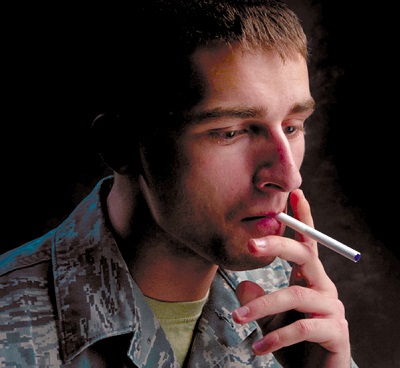In the US Air Force, e-cigarettes are treated in exactly the same way as tobacco cigarettes. That means if any personnel want to reduce the harm they’re doing to themselves through their nicotine addiction, they aren't allowed to unless they stand in designated areas with smokers, who are pumping in excess of 7,000 chemicals out into the air. The fact that the e-cigarette users are releasing primarily water vapor doesn't matter in the eyes of the Air Force, and as if this wasn't enough, the anti e-cig efforts they started in 2010 have been redoubled.
The report in Aerospace News is so full of misleading information that it might as well have been designed explicitly to infuriate vapers. Amongst the most prized kernels of nonsense are that “No matter how it’s used, nicotine is unhealthy,” which comes from the director of the 99th Aerospace Medical Squadron Health and Wellness Center, and a personal favorite, “the acid from the battery also has the potential to leak and be inhaled along with the nicotine.” In case you’re wondering, this is complete nonsense.
They also fall back on old standards, like the long-refuted FDA report of diethylene glycol (which has never been found since) and nitrosamines (present in minute quantities) in e-cigarettes, as well as the idea that they’re some sort of Big Tobacco plot to keep consumers addicted to their product. Aerospace News has littered the article with so many patently absurd statements that they may as well have claimed to have gleaned the information from etchings in a unicorn lair.

The core of the message is familiar, the article stating that “even though e-cigarettes don’t contain a majority of the chemicals found in regular cigarettes, they do contain chemicals that are equally, if not more harmful to those who inhale them.” This probably couldn't be timed any worse, with the recent in-depth study that revealed that e-cigs contain between 9 and a whopping 450 times less toxic compounds than tobacco cigarettes.
Unfortunately, for vapers in the Air Force, these facts are of little comfort. Although it should be nice to know that the sensationalist claims their organization is making are not based on sound reasoning or evidence, the ridiculous, treat-e-cigs-like-tobacco approach seems like it’s enshrined in the Air Force’s stringent tobacco policy. They do report a drastic decline in smokers since the peak year of 2005 (when 25 percent of service members smoked), so their approach is clearly working in some respects, but with e-cigarettes they are missing the mark by a horrendous margin.
Doing anything to discourage the use of a considerably safer alternative is tantamount to encouraging them to go back to the abundant damage done by tobacco. The simple truth is that e-cigs are no more “tobacco” than nicotine patches are, which you would assume don’t have to be used in a designated area under the same rules. They seem to be working under the impression that the only approach to tobacco use is complete abstinence or early death.
E-cigarettes were created specifically because those are not the only options. There is nothing wrong with nicotine in itself (which has been shown in research), and refusing to acknowledge the evident benefits of e-cigs is potentially very, very damaging. Think that’s not true? Put yourself in the shoes of a member of the Air Force considering making the switch. With a natural uncertainty about whether e-cigs are the best approach, do you think you’d be as likely to give them a try if you had to stand out with the smokers anyway?
That’s why approaches and statements like this are so reprehensible. If just one person decides not to try e-cigs because of these ridiculous regulations and later develops one of the multitude of smoking-related illnesses, is the no-exceptions policy really a good thing? It seems like nothing other than an indirect method of causing harm.

